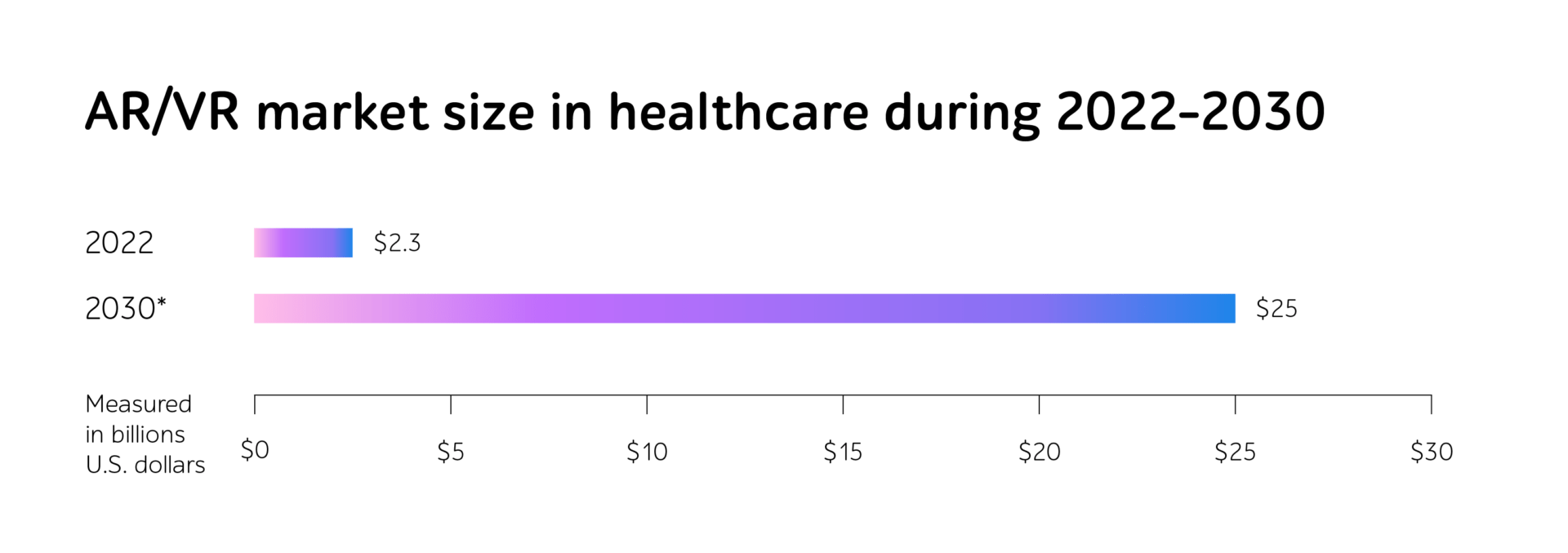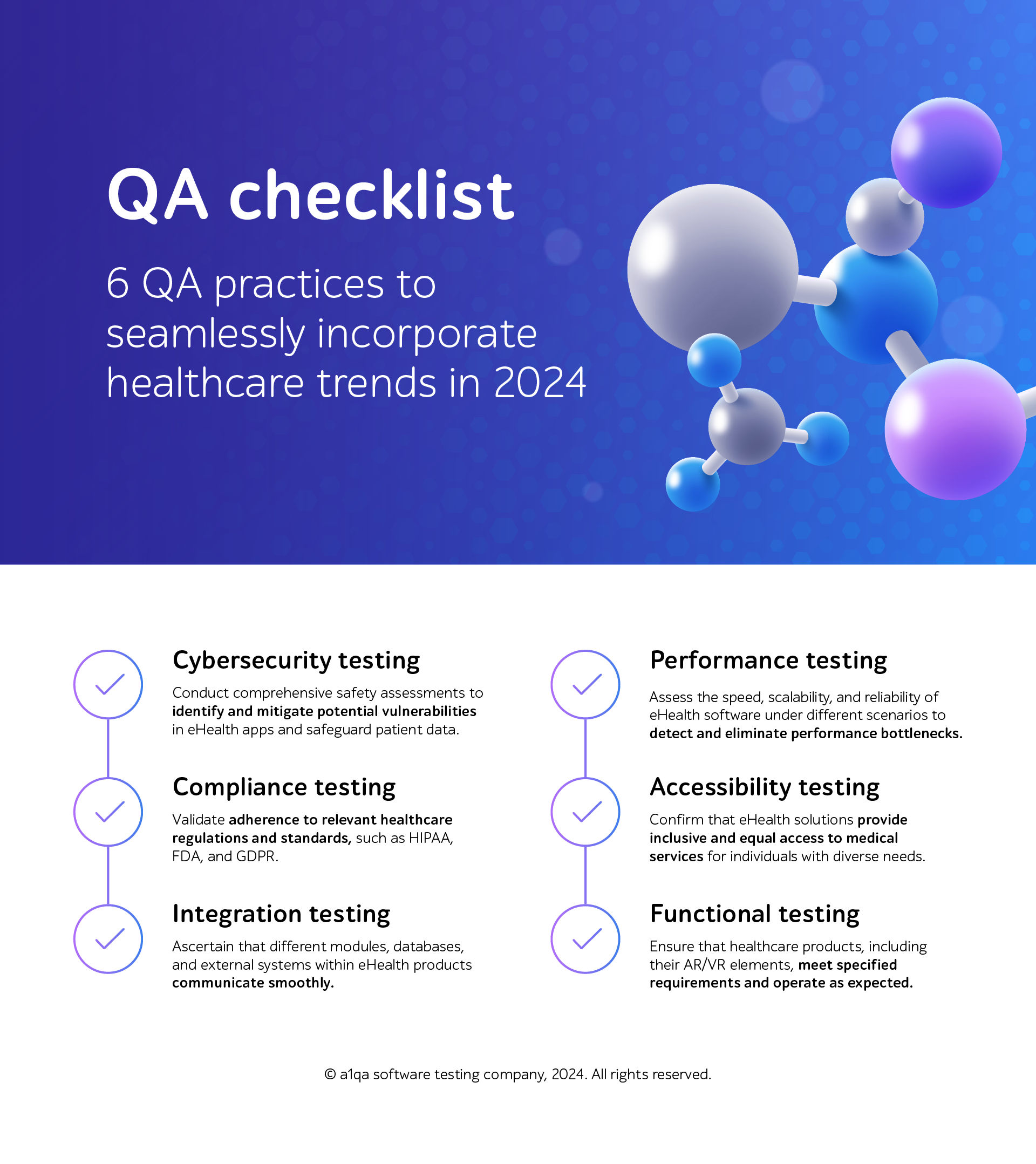
On the pulse of 2024: optimizing the adoption of eHealth trends with QA
As companies navigate the rapidly evolving landscape of medical technology in 2024, it becomes imperative to stay attuned to the latest industry trends, helping revolutionize patient care and eHealth services.
However, to realize the full potential of these innovations, businesses should focus on quality assurance to smoothly implement them. Stringent QA practices serve as a linchpin to ensuring seamless integration of these cutting-edge solutions into existing healthcare systems while allowing companies to meet the highest standards of security, compliance, and reliability.
Let’s look at the predictions of the most impactful digital health trends for 2024!
Trend #1. Generative AI
Generative AI presents a promising avenue for numerous tasks within the healthcare area both related to administrative functions and care delivery. It helps streamline workflows, optimize sleep monitoring, improve radiological imaging, and better predict clinical outcomes. It can be especially valuable in:
- Conducting smart diagnostics. AI-powered solutions use data from electronic health records, imaging, patient conversations, biometrics, and wearable devices to assist doctors in making accurate diagnoses.
- Creating personalized treatment plans. AI tracks an individual’s sleep, nutrition, exercise habits, environmental influences, and vital signs to enable a comprehensive understanding of patients’ health needs.
- Managing population well-being. AI processes large sets of information, identifies risk factors, and analyzes the prevalence of disease within specific demographic groups to improve health indicators.
Another use of generative AI in 2024 is customizing medical products and services. According to McKinsey research, about 1 in 5 US consumers prefer to receive personalized offers and recommendations. Thus, with gen AI, healthcare leaders will be able to provide more tailored experiences, foster greater end-user engagement, and increase patient satisfaction.
Trend #2. Cybersecurity
With the proliferation of digital medical platforms and the increased exchange of sensitive patient information, safeguarding data against cyber threats emerges as a top priority for the healthcare industry.
Just look at these daunting statistics: the number of data breaches in eHealth increased by 93% from 2018 to 2022, with the average cost of one leakage reaching $4.9 million.
Therefore, organizations should adopt robust cybersecurity measures, including encryption protocols, multi-factor authentication, and systematic security audits, to protect end-user privacy, prevent malicious attacks, mitigate the risks of unauthorized access. It will also help uphold consumer trust, ensure regulatory compliance, and maintain the confidentiality and integrity of sensitive medical information.
Trend #3. AR/VR
The AR/VR market size in healthcare is increasingly growing. According to Statista, in 2022, it totaled $2.3 billion while is expected to reach $25 billion in 2030.

Source: Statista
And it’s not a surprise. Companies invest in these technologies as they bring numerous benefits to the table and can be applied for:
- Medical education and training
AR/VR can simulate realistic medical scenarios, allowing healthcare experts to practice surgeries, clinical procedures, and diagnostic skills in a safe and controlled virtual environment.
- Remote consultations
Telemedicine has become an essential component of modern healthcare delivery, enabling people to access medical care from home at any time. AR/VR technologies offer more immersive and interactive experiences for both patients and healthcare providers. With the help of AR/VR technologies, patients receive personalized treatment plans to address their concerns, while healthcare providers can conduct examinations remotely.
- Complex surgical operations modeling
Professionals can use AR/VR to visualize patient anatomy in three dimensions, plan surgical activities, and imitate arduous procedures before performing them in real life, reducing the risk of errors.
- Anxiety treatment
1 in 5 US adults suffer a mental illness. However, only 47.2% of them received the required therapy. AR/VR can bring significant benefits as it promotes a comfortable and risk-free environment for receiving treatment and confronting fears.
With AR/VR innovations at the core of their business strategies, companies can stay ahead of the curve while enhancing the delivery of patient care, improving clinical outcomes, and revolutionizing medical training.
QA practices to implement 2024 eHealth trends with ease
With these trends in mind, we’ve compiled a checklist, featuring 6 key testing types, to assist you in navigating through incorporating eHealth trends in a hassle-free manner. Take a deep dive!
Testing type #1. Cybersecurity testing
Conduct comprehensive safety assessments to identify and mitigate potential vulnerabilities in eHealth apps, safeguard patient data against unauthorized access, and ensure the confidentiality of sensitive information.
Testing type #2. Compliance testing
Validate adherence to relevant healthcare regulations and standards, such as HIPAA, FDA, and GDPR, to mitigate legal risks and maintain consumer trust and confidentiality.
Testing type #3. Integration testing
Ascertain that different modules, databases, and external systems within eHealth products communicate smoothly to mitigate the risk of integration failures and data discrepancies.
Testing type #4. Performance testing
Assess the speed, scalability, and reliability of eHealth software under different scenarios to detect and eliminate performance bottlenecks and ensure consistent and responsive end-user experiences. In case your app is integrated with AR/VR, assess how well it operates under real-life conditions.
Testing type #5. Accessibility testing
Confirm that eHealth solutions provide inclusive and equal access to medical services, including their AR/VR features, for individuals with diverse needs, involving those with disabilities or language barriers.
Testing type #6. Functional testing
Ensure that healthcare products and embedded AR/VR elements within them meet specified requirements and operate as expected while user interactions, data processing, and system workflows have no inconsistencies.

Briefly
In 2024, healthcare providers can leverage these industry trends — generative AI, cybersecurity, and AR/VR — to stay one step ahead of market competition and innovate the delivery of patient care.
As the process of incorporating tech tendencies into current workflows entails several hurdles, businesses should focus on QA practices to ease the path. They include cybersecurity, compliance, integration, performance, accessibility, and functional testing.
In case you’d like to get professional advice on improving the quality of your eHealth solutions, get hold of a1qa’s team.








